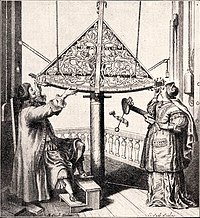This is an old revision of this page, as edited by Matthead (talk | contribs) at 02:07, 26 September 2009. The present address (URL) is a permanent link to this revision, which may differ significantly from the current revision.
Revision as of 02:07, 26 September 2009 by Matthead (talk | contribs)(diff) ← Previous revision | Latest revision (diff) | Newer revision → (diff)
Elisabeth Catherina Koopmann Hevelius (1647 - 1693) (in Polish also called Elżbieta Heweliusz) was the second wife of Johannes Hevelius. Like her husband, she was also an astronomer.
Elisabeth Koopmann (or Kaufmann, Template:Lang-de) was, like Hevelius and his first wife, a member of a rich merchant family in the Hanseatic League city of Danzig (Gdansk).
Her marriage to Hevelius in 1663 allowed her to pursue her own interest in astronomy by helping him manage his observatory in Danzig. Following his death in 1687, she completed and published Prodromus astronomiae (1690), their jointly compiled catalogue of 1,564 stars and their positions.
She is considered one of the first female astronomers, and called "the mother of moon charts". Her life was recently novelized as The Star Huntress (2006).
The minor planet 12625 Koopman is named in her honour, as is the crater Corpman on Venus.
References
- Oglive, M. B. 1986. Women in Science. The MIT Press. ISBN 026215031X
- Walz, E. 2006. The Star Huntress. Random House/Bertelsmann. ISBN 9783442365234